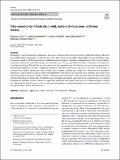Files in this item
Intra-community infanticide in wild, eastern chimpanzees : a 24 year review
Item metadata
| dc.contributor.author | Lowe, Adriana E. | |
| dc.contributor.author | Hobaiter, Catherine | |
| dc.contributor.author | Asiimwe, Caroline | |
| dc.contributor.author | Zuberbuhler, Klaus | |
| dc.contributor.author | Newton-Fisher, Nicholas E. | |
| dc.date.accessioned | 2019-05-28T14:30:01Z | |
| dc.date.available | 2019-05-28T14:30:01Z | |
| dc.date.issued | 2019-05-27 | |
| dc.identifier | 258978824 | |
| dc.identifier | 485bfb3d-d57e-4ee3-aaa0-b65f63aa9c53 | |
| dc.identifier | 85072029413 | |
| dc.identifier | 000511805100008 | |
| dc.identifier.citation | Lowe , A E , Hobaiter , C , Asiimwe , C , Zuberbuhler , K & Newton-Fisher , N E 2019 , ' Intra-community infanticide in wild, eastern chimpanzees : a 24 year review ' , Primates , vol. First Online . https://doi.org/10.1007/s10329-019-00730-3 | en |
| dc.identifier.issn | 0032-8332 | |
| dc.identifier.other | ORCID: /0000-0002-3893-0524/work/58055475 | |
| dc.identifier.other | ORCID: /0000-0001-8378-088X/work/64360683 | |
| dc.identifier.uri | https://hdl.handle.net/10023/17773 | |
| dc.description | AEL was supported by a University of Kent 50th Anniversary scholarship. | en |
| dc.description.abstract | Infanticide is well documented in chimpanzees and various hypotheses have been proposed to explain this behaviour. However, since infanticide by chimpanzees is relatively rare, it has thus far not been possible to thoroughly test these hypotheses. Here we present an analysis of the largest dataset of infanticides from a single community of chimpanzees, a full record of all intra-community infanticides and failed attempts at infanticide over a 24-year period for the Sonso community of chimpanzees in the Budongo Forest, Uganda. We use these data to test four hypotheses for this behaviour: sexual selection, resource competition, meat acquisition and male mating competition. There were 33 attacks on 30 victims, 11 of which were ‘definite’ infanticides, four of which ‘almost certain’, and nine were ‘suspected’, while nine were ‘attempted’ infanticides. The majority of attacks where the perpetrators were known (23) had only male attackers and victims were disproportionally young (2/3 of victims with known ages were under one week old). Our data best support the sexual selection hypothesis for infanticide. Cannibalism was infrequent and partial, suggesting meat acquisition was a by-product of infanticide, and there was no evidence to suggest that infanticide was part of a male strategy to eliminate future competitors. Infanticide by females was rare, but we suggest sexual selection, operating through intra-sexual competition, may also be responsible for infanticide by females. | |
| dc.format.extent | 14 | |
| dc.format.extent | 741462 | |
| dc.language.iso | eng | |
| dc.relation.ispartof | Primates | en |
| dc.subject | Infanticide | en |
| dc.subject | Aggression | en |
| dc.subject | Sexual selection | en |
| dc.subject | Pan troglodytes | en |
| dc.subject | Budongo | en |
| dc.subject | BF Psychology | en |
| dc.subject | NDAS | en |
| dc.subject.lcc | BF | en |
| dc.title | Intra-community infanticide in wild, eastern chimpanzees : a 24 year review | en |
| dc.type | Journal article | en |
| dc.contributor.institution | University of St Andrews. Centre for Social Learning & Cognitive Evolution | en |
| dc.contributor.institution | University of St Andrews. School of Psychology and Neuroscience | en |
| dc.contributor.institution | University of St Andrews. Institute of Behavioural and Neural Sciences | en |
| dc.identifier.doi | 10.1007/s10329-019-00730-3 | |
| dc.description.status | Peer reviewed | en |
This item appears in the following Collection(s)
Items in the St Andrews Research Repository are protected by copyright, with all rights reserved, unless otherwise indicated.

